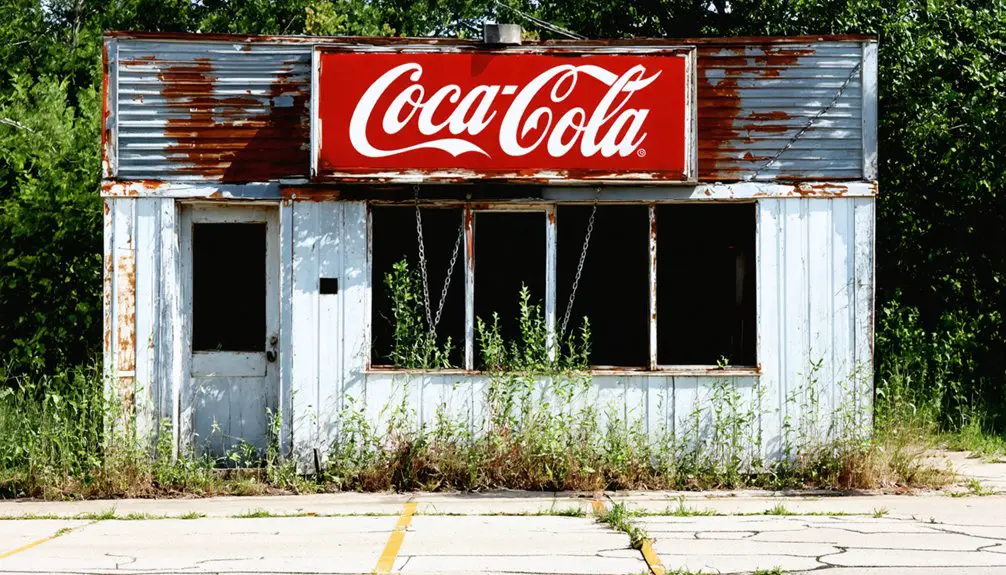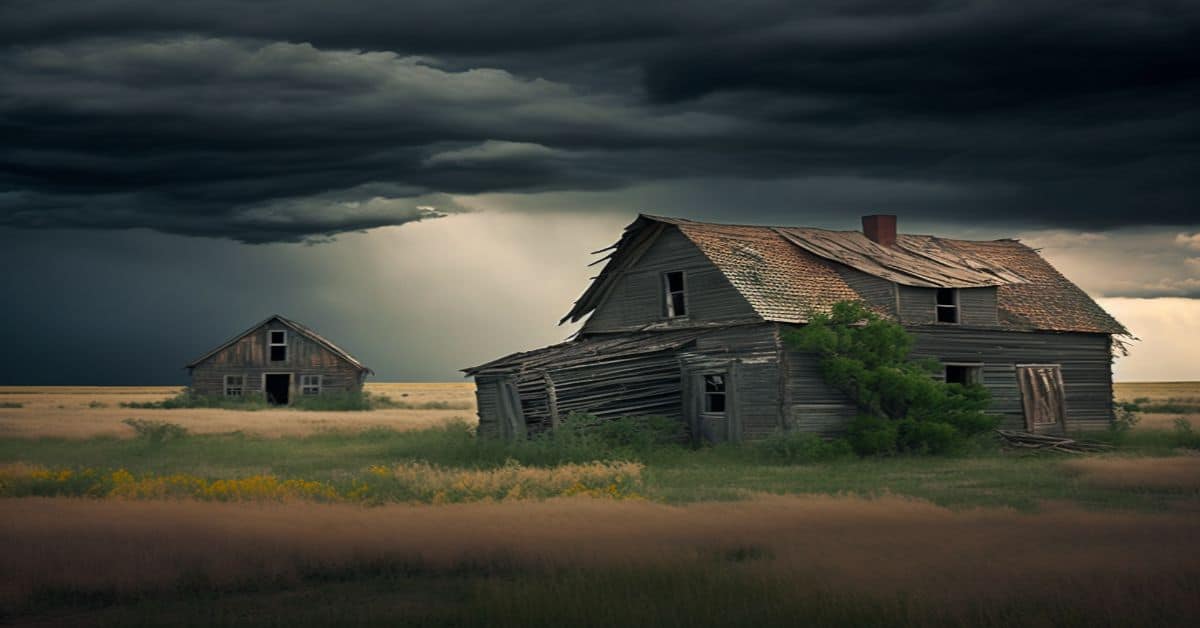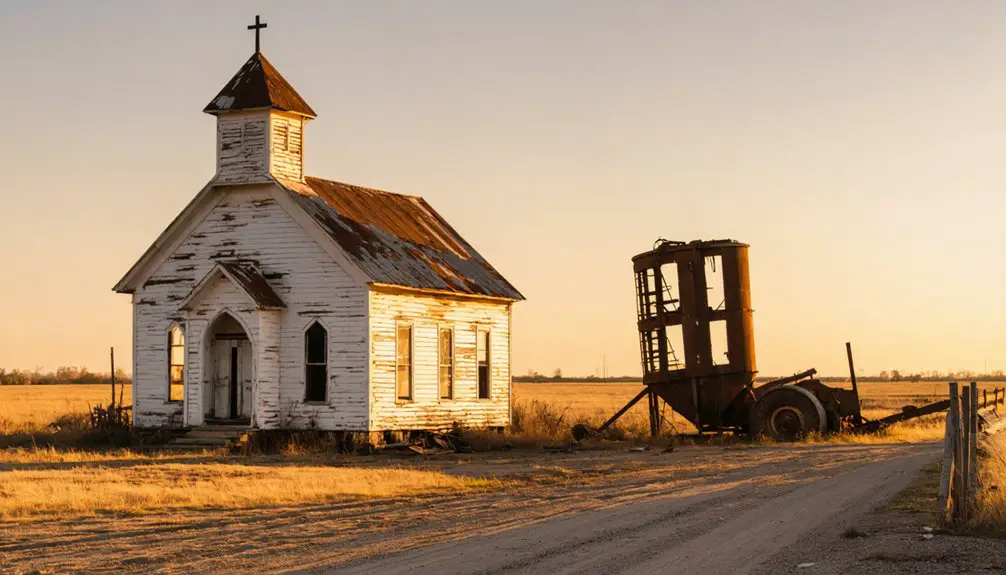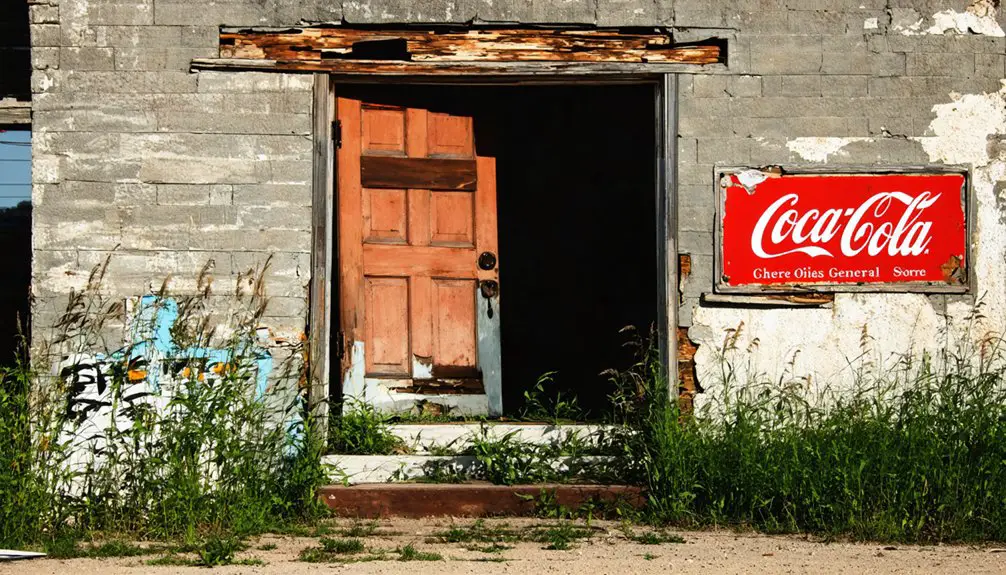You’ll find the original Hochatown, Oklahoma – a historic Choctaw settlement and once-thriving timber town – now submerged beneath Broken Bow Lake. Founded by Hocha, a Trail of Tears survivor in the 1830s, the town flourished as a lumber hub until 1960, when the U.S. Army Corps of Engineers flooded it for a dam project. Today, the underwater ruins, including the infamous Olde Hochatown Store where Levi Davis’s ghost story began, hold countless untold tales of Oklahoma’s frontier past.
Key Takeaways
- Original Hochatown lies underwater beneath Broken Bow Lake since 1960, when the U.S. Army Corps of Engineers constructed a dam.
- The submerged town includes historical structures like the Olde Hochatown Store, homes, and Native American settlements dating back to 6,000 B.C.
- Residents were forced to relocate, abandoning the original townsite and rebuilding their community in a new location nearby.
- Scuba divers can explore the underwater ruins, though sedimentation affects visibility of archaeological artifacts and structures.
- The ghost story of Levi Davis, who was killed in 1890s Hochatown, remains tied to the submerged location.
Native American Roots and Settlement
While many Oklahoma towns trace their origins to the late 1800s, Hochatown’s history extends thousands of years earlier, with archaeological evidence revealing human habitation dating back to 6,000 B.C.
You’ll find spear points near the Mountain Fork River that tell the story of prehistoric hunters who first called this land home. The area’s rich archaeological sites showcase Paleo Indian artifacts spanning multiple cultural periods, from Archaic to Plains Village.
The Caddo influence dominated the region from 1,000 A.D. to 1791 A.D., leaving behind impressive mound groups now listed in the National Register of Historic Places.
When the Choctaw arrived in the 1820s, they established sovereignty over these resource-rich lands, naming the settlement after a tribal member called Hocha who arrived during the Trail of Tears in 1833. The original settlement remained until the mid-1960s relocation when dam construction forced residents to move. The community later established a post office in 1894 as it developed into a thriving trade area.
The Trail of Tears Connection
You’ll find Hochatown’s origins deeply intertwined with the tragic Trail of Tears, when the Choctaw people were forcibly relocated from their ancestral southeastern lands to present-day Oklahoma in the 1830s.
The town bears the name of Hocha, a Choctaw survivor who settled near the Mountain Fork River after enduring the brutal 500-mile journey that claimed thousands of lives.
Under Choctaw governance for 75 years following removal, the area became a representation of Native resilience as the displaced people built new communities despite their devastating losses. The Choctaw Nation emerged as the largest economic power in Indian Territory by 1860, demonstrating remarkable recovery despite the trauma of forced relocation.
Today, the Choctaw Nation continues its influence in the region through major infrastructure investments and development of a new resort.
Choctaw Forced Relocation Impact
The devastating impact on the Choctaw people included:
- Loss of approximately 25% of their population due to disease, starvation, and exposure
- Surrender of one million acres of ancestral homeland
- Severed connections to sacred sites and traditional ways of life
- Disrupted tribal governance and communal land systems
Despite these tremendous challenges, the historical memory of their forced relocation continues to shape Choctaw identity through ceremonial remembrance and educational initiatives. Throughout the early removals, disorganized federal agents often mismanaged resources and supplies meant to support the Choctaw people during their difficult journey. The term “Trail of Tears” was first used to describe the Choctaw removal in 1831, before being applied to other tribal relocations.
Hocha’s Settlement Story
Among the countless stories of survival during the Trail of Tears, one Choctaw Indian named Hocha left an enduring mark on Oklahoma’s history.
In 1833, after enduring disease, starvation, and death along the brutal forced relocation from Mississippi, Hocha’s resilience led him to establish a new life along the Mountain Fork River.
You’ll find his legacy in the town that still bears his name, though the original settlement now lies beneath Broken Bow Lake.
Hocha helped build a thriving Choctaw community that preserved their traditions despite displacement.
His settlement became a sanctuary where fellow Choctaw people could rebuild their lives, maintaining their cultural practices and social structures brought from their ancestral lands, years before white settlers arrived in the territory.
The community’s dedication to education was evident through the establishment of the Choctaw National School system, which began operating in 1842.
Native Community Building Legacy
Following their forced relocation along the Trail of Tears, Native American communities demonstrated remarkable resilience by rebuilding their societies in Indian Territory. Through community resilience and cultural preservation efforts, tribes like the Cherokee and Choctaw established new foundations in what would become Oklahoma. The massive relocation opened 25 million acres for white settlement, highlighting the immense scale of land dispossession that Native Americans endured.
Multiple tribes came together to form complex multi-tribal communities, creating new social structures while maintaining their distinct cultural identities.
The Cherokee Nation developed their 1839 Constitution, adapting their pre-removal governance system to new circumstances. Supreme Court rulings provided no protection against forced removal, yet tribes persevered in maintaining their sovereignty.
Despite devastating population losses, survivors preserved traditional practices and rebuilt tribal institutions.
Today’s Native communities in Oklahoma honor their ancestors’ strength through annual commemorative events, including the Choctaw Nation’s 500-mile cycling journey.
These enduring legacies of survival continue to inspire future generations who value freedom and cultural sovereignty.
Life in Original Hochatown
You would’ve found daily life in original Hochatown centered around the bustling timber industry, where sawmills processed lumber from the surrounding Ouachita Mountains.
The town’s strategic location near the Mountain Fork River and Oklahoma and Gulf Railway made it an important trading hub, allowing residents to ship timber products and receive essential supplies.
Local general stores served as community gathering spots where you could trade goods, share news, and conduct business with fellow townspeople. As a proud Choctaw Nation settlement, the town maintained strong cultural ties to its Native American heritage while welcoming diverse newcomers.
Daily Town Activities
Life in original Hochatown revolved around a vibrant mix of crucial institutions and daily survival activities. You’d find your daily routines centered around the town’s essential institutions – the post office, school, and church – where community gatherings strengthened social bonds between Choctaw natives and settlers alike.
- You could trade goods at local markets or catch the Oklahoma and Gulf Railway for broader commerce.
- You’d spend time hunting, fishing, and foraging in the Mountain Fork River area.
- Your children would split their time between schooling and helping with farming chores.
- You might’ve participated in the thriving moonshine trade, utilizing local corn and water resources.
The town’s remote location in the Ouachita Mountains meant you’d rely heavily on these self-sustaining activities, while transportation networks kept you connected to the wider region.
Trading and Timber Industry
The bustling timber trade transformed Hochatown from a modest Choctaw settlement into a thriving sawmill village in the late 1800s. You’d have seen massive logs from the Ouachita Mountains being hauled to the town’s sawmills, where they’d be processed for lumber and railroad ties.
Timber transportation relied heavily on the Missouri, Kansas and Texas Railway, with products reaching markets as far as Dallas and Kansas City.
Economic fluctuations kept you on your toes in Hochatown. While the Choctaw Lumber and Coal Company’s infrastructure brought prosperity through legal trade, tough times led some locals to moonshine production.
The town’s fortunes rose and fell with timber demand, even as wildfires periodically threatened the forests. Despite these challenges, you’d have witnessed the timber industry fostering a diverse community where Choctaw families and European settlers worked side by side.
The Great Flood and Relocation
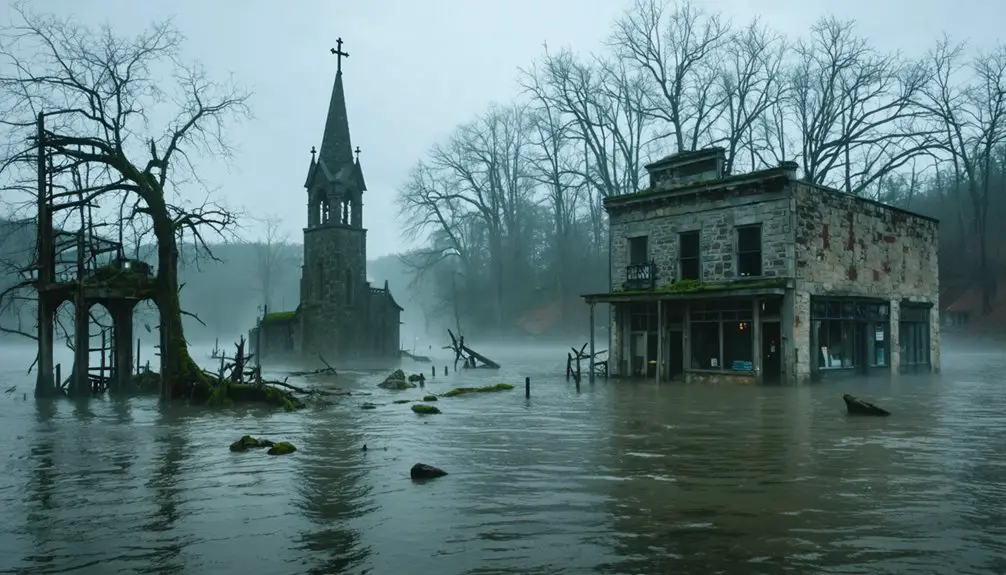
During 1960, a monumental change forever altered Hochatown’s landscape when the U.S. Army Corps of Engineers flooded the original townsite to construct a dam on the Mountain Fork River.
The flood impact was immediate and complete, submerging every structure beneath Broken Bow Lake’s waters. Despite having fewer than 100 residents at the time, the community’s resilience shone through as they relocated to higher ground.
- The original town lost its post office, ZIP code, and government recognition
- Residents rebuilt their community infrastructure from scratch at the new location
- The flooding erased centuries of history, from Native American settlements to early pioneer activities
The new Hochatown eventually incorporated in 2015, transforming into a tourist destination with cabin rentals and recreational activities.
Beneath Broken Bow Lake
Deep beneath Broken Bow Lake‘s crystal-clear waters lies a preserved snapshot of Oklahoma history, where the original Hochatown rests frozen in time since its submersion in 1968.
You’ll find submerged structures including remnants of the Olde Hochatown Store, homes, and infrastructure that tell the story of early 20th-century life in this former timber town.
The lake’s waters protect archaeological artifacts spanning thousands of years, from prehistoric spear points to Caddo Indian settlements dating back to 1,000 A.D.
While sedimentation poses preservation challenges, you can still explore these underwater ruins through scuba diving.
The clear waters reveal glimpses of the town’s artifacts, though some treasures remain hidden beneath layers of sediment, waiting to share their secrets of Oklahoma’s rich cultural heritage.
Tales of Levi Davis’s Ghost
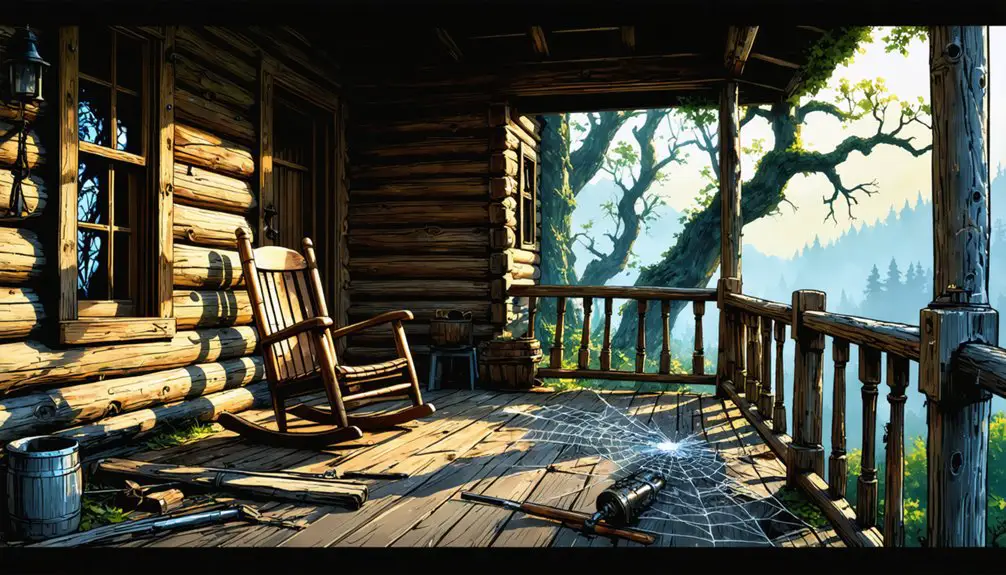
Among Hochatown’s most enduring legends, Levi Davis’s ghost story traces back to a fatal confrontation at the original Hochatown Store. After being gunned down by Mr. Kincaid over a pay dispute in the 1890s, Levi’s legacy lives on through reported ghostly encounters at the recreated store in Beavers Bend Forest Heritage Center.
- Unexplained movements and sounds keep employees on edge
- The original murder site lies submerged beneath Broken Bow Lake
- Local tourism thrives on guided ghost tours featuring Levi’s tale
- The story symbolizes frontier justice and early Oklahoma’s untamed spirit
You’ll find Levi’s story woven deeply into Hochatown’s cultural fabric, where his restless spirit serves as a haunting reminder of the region’s rugged past.
The tale continues drawing curious visitors seeking connections to this dramatic chapter of Oklahoma’s frontier history.
From Timber Town to Tourist Haven
The original Hochatown’s transformation from a modest timber settlement to a thriving tourist destination spans over 150 years of dramatic change.
What began as a remote Choctaw settlement in the 1800s flourished into a bustling timber industry hub by the early 1900s, with the Choctaw Lumber Company driving regional development.
When the Great Depression hit, locals turned to moonshine production to survive, using the area’s abundant corn and water resources.
Everything changed in 1968 when the Army Corps of Engineers submerged the original town under Broken Bow Lake.
The relocated Hochatown quickly reinvented itself, shifting from its timber industry roots to a tourist economy.
Today, you’ll find a vibrant vacation destination where visitors flock to enjoy the mountains, lake activities, and outdoor recreation at nearby Beavers Bend State Park.
Preserving Historical Heritage
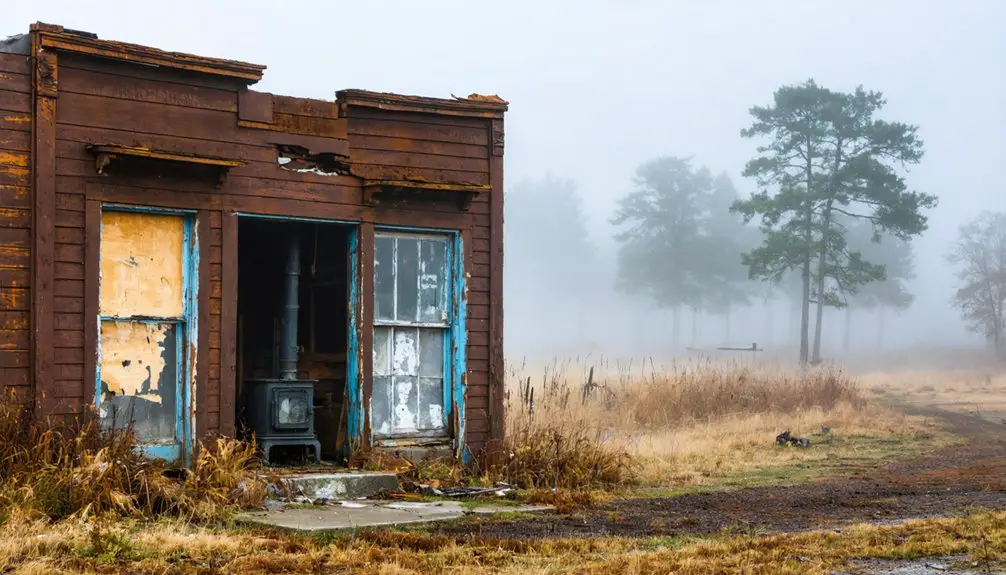
While Broken Bow Lake submerged the original Hochatown in 1968, preservation efforts guaranteed its historical legacy wouldn’t vanish beneath the waters. The U.S. Army Corps of Engineers and preservation agencies demonstrated remarkable community resilience by relocating key structures to maintain historical continuity.
Though waters rose over old Hochatown, determined preservation work ensured its heritage lived on through carefully relocated historic structures.
You’ll find evidence of this careful preservation through:
- The original post office building (1894-1964), which still stands as a symbol of the town’s heritage
- Relocated churches, homes, and cemetery that preserved community bonds
- Historical records and oral histories documenting pre-lake life
- Protected archaeological sites showcasing Choctaw and early settler history
Today, you can explore these preserved elements that connect modern Hochatown to its rich past, while scuba divers can glimpse remnants of the original town beneath Broken Bow Lake’s surface.
Modern Attractions and Recreation
Modern Hochatown has transformed from its submerged origins into a vibrant tourist destination, offering diverse entertainment options that range from cutting-edge virtual reality experiences to traditional outdoor adventures.
You’ll find virtual adventures at The Cave VR, where you can battle zombies or explore distant planets. Meanwhile, BigFoot Speedway combines physical thrills with a VR 3D rollercoaster.
For outdoor activities, you can navigate the 29,000-square-foot MAZE, enjoy water sports at Broken Bow Lake, or fish the Mountain Fork River with expert guides.
The area’s entertainment scene includes magic shows at Hester’s Theatre, live music at Hochatown Saloon, and gaming at Choctaw Landing Casino.
Local breweries and distilleries round out the experience, with Mt Fork Brewery and Hochatown Distilling Co. offering tours and tastings.
Frequently Asked Questions
How Deep Underwater Are the Remains of Old Hochatown Today?
You’ll find submerged structures from 30 to 185 feet deep in Broken Bow Lake, though underwater exploration becomes challenging past 60 feet due to thick silt and diminished visibility.
What Happened to Families Who Refused to Relocate During Flooding?
Despite their resistance stories, families lost their property rights and were forcefully evicted as waters rose. You’ll find they faced legal pressure until they had to abandon homes, creating lasting community impact.
Are There Guided Scuba Tours to Explore Submerged Hochatown Ruins?
You won’t find guided tours specifically for the ruins, but you can explore independently with your scuba equipment and underwater photography gear. Local dive resources are limited, requiring self-guided exploration.
What Was the Total Cost of Relocating the Entire Town?
You’d think moving an entire town would leave a paper trail, but ironically, there’s no documented total for Hochatown’s relocation expenses. Records from this 1950s town history remain mysteriously incomplete.
Did Any Original Buildings Survive the Move to Present-Day Hochatown?
You’ll find that historic architecture survival was limited, with preservation efforts saving only the church and cemetery, which were relocated to present-day Hochatown. Other original buildings remain submerged underwater.
References
- http://blogoklahoma.us/place/197/mccurtain/hochatown
- https://www.youtube.com/watch?v=hO4PwXNHEYM
- https://www.okhistory.org/publications/enc/entry?entry=GH002
- https://thingstodoinbrokenbowok.com/f/who-built-hochatown-reflecting-on-a-communitys-true-origin
- https://www.youtube.com/watch?v=BH3RSXTWdOo
- https://www.southwestledger.news/news/battle-hochatown
- https://www.okhistory.org/publications/enc/entry?entry=IN018
- https://www.okhistory.org/publications/enc/entry?entry=MC017
- https://brokenbowareachamber.com/historical-overview/
- https://www.choctawnation.com/biskinik/news/the-trail-of-tears-why-we-remember/
